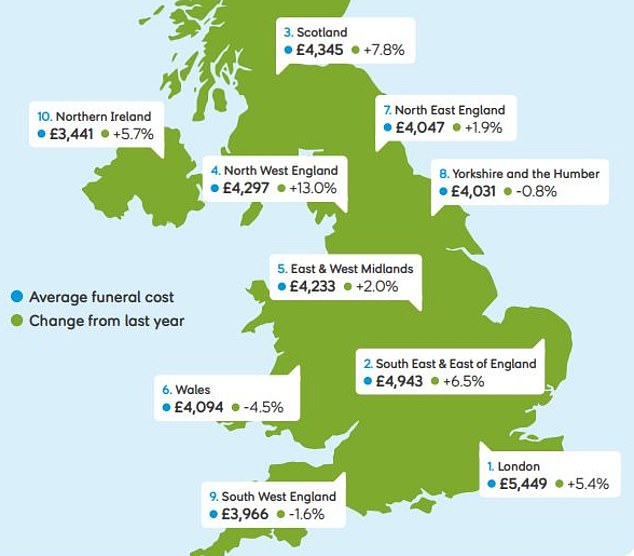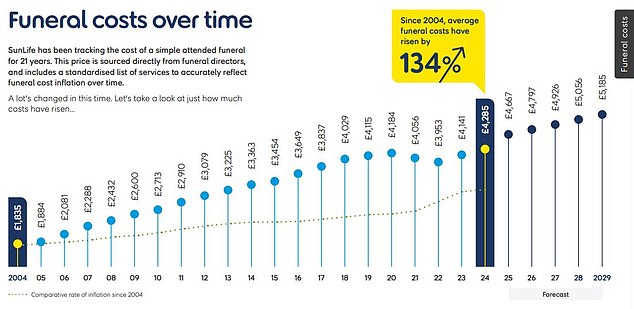The price of a basic funeral has hit a record £4,285, with rising burial and crematorium fees, along with staff salaries, driving up costs.
The average price has risen 3.5 per cent over the past year, surpassing the pre-pandemic high of £4,194.
Costs fell during Covid-19 restrictions, when people opted for direct cremations or limited ceremonies with few mourners.
A subsequent rule change that forced funeral directors to display price menus also reduced the cost of saying goodbye to loved ones.
A basic funeral covers a cremation or burial, all funeral director fees, a mid-range casket, a funeral limousine, a doctor and a minister or celebrant.
The average price has increased 134 percent since 2004, when financial services company SunLife began conducting an annual study on the cost of dying.
Mourning a loved one: A basic send-off covers a cremation or burial, funeral director’s fees, a mid-range casket, and a limousine.
SunLife says if costs had risen at the same rate as inflation over the past 21 years, the average figure would be 75 per cent higher, at £3,211.
The company, which interviewed 100 funeral directors across the UK and around 1,500 people who recently organized a funeral, found that the price of direct cremations rose the most last year.
The cost increased 6.6 per cent to £1,597, but it is still the cheapest option.
Direct cremations are carried out without a service or mourners, but the ashes are later returned to the family, allowing them to arrange a personal funeral at a time of their choosing.
SunLife research found that families are more likely to opt for this type of send-off if they discussed funeral wishes with a loved one before they died.
About 57 percent of families who chose a direct cremation said they did so at the request of the deceased, while 30 percent said it was easier to arrange and 14 percent preferred to spend the money on something else.

The firm says the number of direct cremations increased during the pandemic out of necessity, but they remain popular and now account for one in five of all funerals, up from 14 per cent in 2020 and 3 per cent in 2019.
SunLife found the cost of a full farewell rose 1.4 per cent to a record £9,797 last year.
That covers a memorial, death and funeral notices, flowers, order forms, limousines, the venue and catering for a wake, as well as hiring a professional to administer an estate.
In terms of regional price differences, London, the South East and the East of England remain the most expensive places to hold a funeral, while Northern Ireland is the cheapest.
SunLife says seven in 10 regions experienced an increase in funeral costs this year (see below).

“We talk to hundreds of funeral directors each year as part of the Cost of Dying Report research, and they tell us that funeral costs are rising faster than inflation for a combination of reasons,” says Jordan Flynn, SunLife research manager.
‘The main reason cited is rising fees for cremations, burials and associated services, driven by limited space for burials and higher energy costs for crematoriums: 60 percent of funeral directors say the Rising fuel prices are the main reason for the rise in crematoriums. costs – and councils increase their costs to recover greater losses.’
“Other third-party costs and overhead, such as construction costs and wholesale casket prices, are also driving price increases, along with hiring and staffing cost issues in the funeral director industry.” .
Flynn adds that the biggest variation between regions is the cost of burial. A double-depth plot costs £595 on average in Northern Ireland, but £4,322 in London.

The SunLife report found that one in five families experienced financial difficulties when trying to pay for a funeral.
A third of those in this situation turn to savings and investments, while around a quarter put it on a credit card, a similar number borrow the money from a friend or family member and one in five sell their money. belongings to cover the cost.
The company’s research among funeral directors found that 47 percent have noticed an increase in the number of grieving families seeking and obtaining quotes from different providers.
However, about 63 percent of people who have arranged funerals said they did not compare prices between companies, and 45 percent said their deceased loved one had specified which funeral director they wanted before they died.
How to reduce funeral costs
Ways to keep the price manageable include a cheaper casket, spending less on flowers and holding a wake at home, according to the SunLife report.
Other budgetary measures include seeking quotes, choosing not to embalm, opting for direct cremation, not renting a hearse or limousine, and not having service order cards.
The main advice from funeral directors is to reduce flower consumption, followed by not using limousines and reducing catering costs.
They say that instead of spending hundreds of pounds on flowers, make a simple tribute on behalf of everyone and go to a local florist instead of using the services of the funeral director.
SunLife also asked families who had organized funerals in the past four years for money-saving tips. Here is a selection of his comments taken from the report.
‘Embalmment. “We didn’t know we didn’t need it and we didn’t understand what it was or what it would do.”
‘Death and funeral notices in local newspapers. Nobody saw them anyway. That’s not how things are done nowadays.
‘Buy so many flowers. I didn’t really need them because a lot of people brought them themselves.’
“Too many copies of death certificates.”
“Rent two limousines; you only need one.”
Some links in this article may be affiliate links. If you click on them, we may earn a small commission. That helps us fund This Is Money and keep it free to use. We do not write articles to promote products. We do not allow any commercial relationship to affect our editorial independence.


